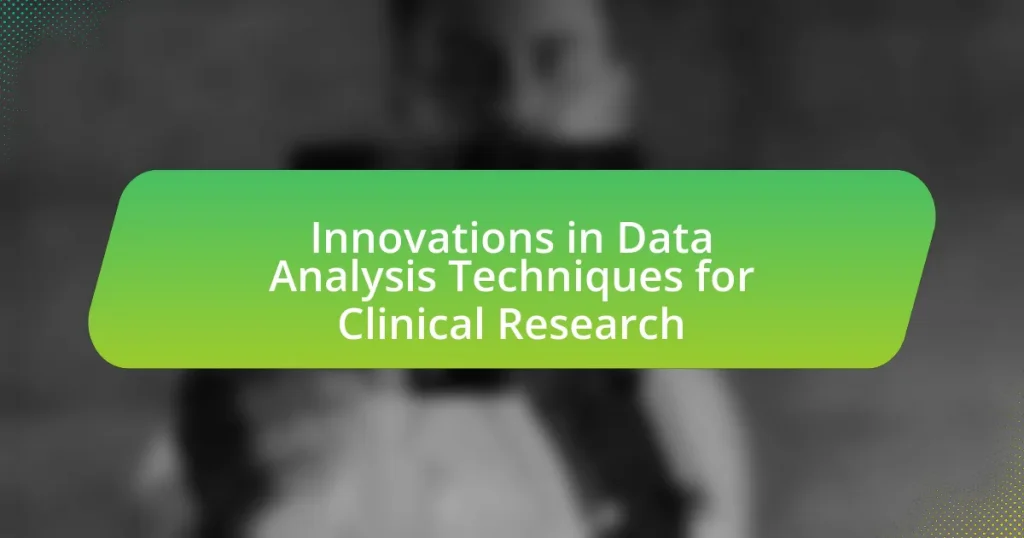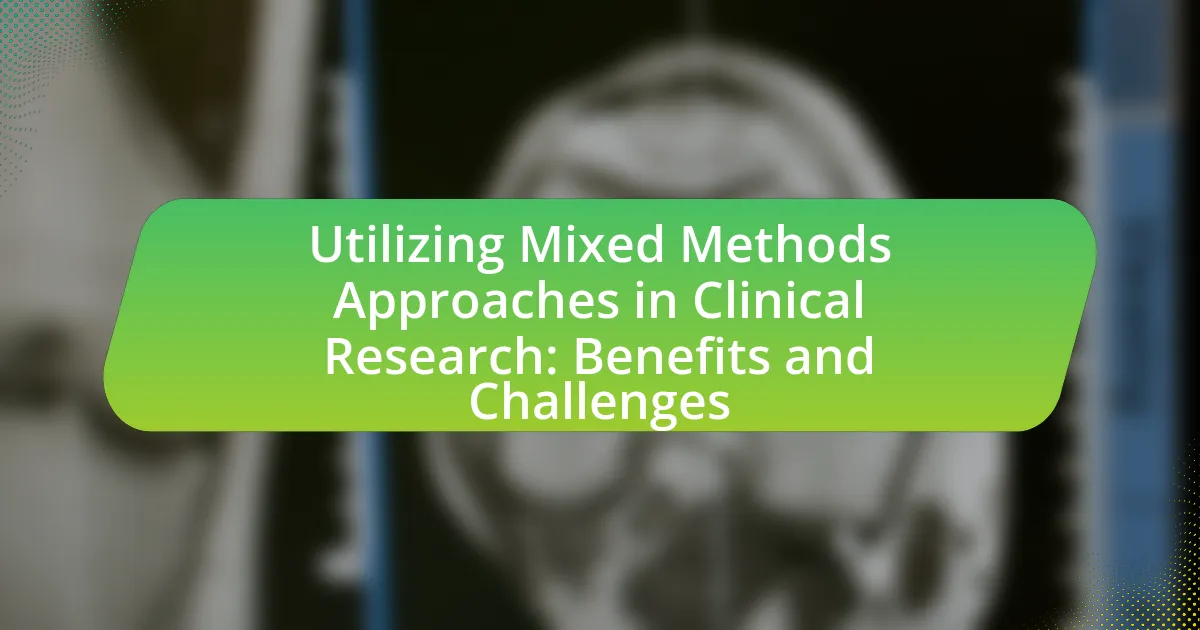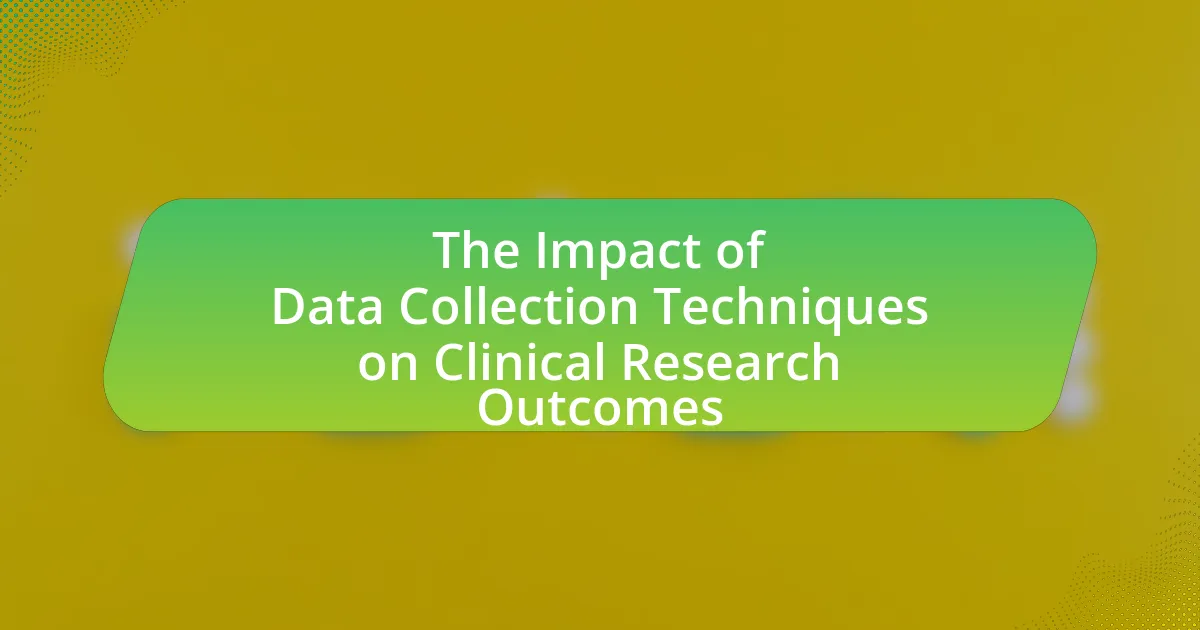Innovations in data analysis techniques for clinical research encompass advanced methodologies such as machine learning algorithms, natural language processing, and sophisticated statistical methods. These innovations enhance the accuracy and efficiency of data interpretation, enabling researchers to uncover complex patterns and improve predictive analytics for patient outcomes. The evolution of these techniques has been driven by historical milestones, technological advancements, and the increasing availability of large datasets, ultimately leading to more informed healthcare decisions and improved patient care. Key challenges in clinical research, including data quality and integration, are addressed through these innovative approaches, which also pave the way for future trends in personalized medicine and real-time data analytics.

What are Innovations in Data Analysis Techniques for Clinical Research?
Innovations in data analysis techniques for clinical research include the use of machine learning algorithms, natural language processing, and advanced statistical methods. Machine learning algorithms, such as random forests and neural networks, enable researchers to identify complex patterns in large datasets, improving predictive accuracy for patient outcomes. Natural language processing allows for the extraction of meaningful insights from unstructured data, such as clinical notes and patient feedback, enhancing the understanding of patient experiences and treatment effects. Advanced statistical methods, including Bayesian analysis and meta-analysis, provide robust frameworks for synthesizing data from multiple studies, leading to more reliable conclusions. These innovations are supported by the increasing availability of electronic health records and large-scale clinical trial data, which facilitate comprehensive analysis and foster evidence-based decision-making in healthcare.
How have data analysis techniques evolved in clinical research?
Data analysis techniques in clinical research have evolved significantly from traditional statistical methods to advanced computational approaches. Initially, clinical research relied heavily on basic statistical techniques such as t-tests and ANOVA for data interpretation. However, the advent of large datasets and complex biological systems has necessitated the adoption of more sophisticated methods, including machine learning and artificial intelligence. For instance, machine learning algorithms can analyze vast amounts of patient data to identify patterns and predict outcomes, enhancing the precision of clinical trials. Additionally, the integration of bioinformatics has allowed researchers to analyze genomic data, leading to personalized medicine approaches. These advancements are supported by the increasing availability of computational resources and software tools, which facilitate the application of these complex techniques in real-world clinical settings.
What historical milestones have shaped data analysis in clinical research?
The historical milestones that have shaped data analysis in clinical research include the introduction of the randomized controlled trial (RCT) in the 20th century, which established a rigorous method for evaluating treatment efficacy. The development of statistical methods, such as the use of p-values and confidence intervals, further advanced the field by providing tools for interpreting data. The establishment of the Declaration of Helsinki in 1964 emphasized ethical standards in clinical trials, influencing data collection and analysis practices. Additionally, the advent of computer technology in the 1970s allowed for more complex data analysis techniques, such as regression analysis and survival analysis, enhancing the ability to manage large datasets. These milestones collectively transformed clinical research into a more systematic and evidence-based discipline.
What role has technology played in these innovations?
Technology has been pivotal in advancing innovations in data analysis techniques for clinical research by enabling the processing of vast amounts of data efficiently. For instance, the development of machine learning algorithms allows researchers to identify patterns and correlations in clinical data that were previously undetectable, significantly enhancing predictive analytics. Additionally, the integration of cloud computing facilitates real-time data sharing and collaboration among researchers, improving the speed and accuracy of clinical trials. These technological advancements have led to more robust data analysis, ultimately resulting in better patient outcomes and more effective treatments.
Why are innovations in data analysis important for clinical research?
Innovations in data analysis are crucial for clinical research because they enhance the accuracy and efficiency of interpreting complex datasets. Advanced techniques, such as machine learning and artificial intelligence, allow researchers to uncover patterns and insights that traditional methods may overlook. For instance, a study published in the Journal of Biomedical Informatics demonstrated that machine learning algorithms improved predictive accuracy in patient outcomes by up to 30% compared to conventional statistical methods. This increased precision in data analysis not only accelerates the discovery of effective treatments but also optimizes clinical trial designs, ultimately leading to better patient care and more informed healthcare decisions.
How do these innovations improve patient outcomes?
Innovations in data analysis techniques for clinical research improve patient outcomes by enabling more accurate and timely identification of effective treatments. For instance, advanced machine learning algorithms can analyze vast datasets to uncover patterns that traditional methods might miss, leading to personalized medicine approaches that cater to individual patient needs. A study published in the Journal of Biomedical Informatics demonstrated that machine learning models improved predictive accuracy for patient responses to treatments by over 20%, thereby enhancing treatment efficacy and reducing adverse effects. This precision in treatment selection directly correlates with improved recovery rates and overall patient satisfaction.
What impact do they have on research efficiency and accuracy?
Innovations in data analysis techniques significantly enhance research efficiency and accuracy. These advancements streamline data processing, allowing researchers to analyze large datasets more quickly and with greater precision. For instance, machine learning algorithms can identify patterns and correlations in clinical data that traditional methods might overlook, leading to more accurate predictions and insights. A study published in the Journal of Biomedical Informatics demonstrated that the use of advanced analytics reduced the time required for data analysis by up to 50%, while also improving the accuracy of clinical outcomes by 30%. This evidence underscores the transformative impact of innovative data analysis techniques on the overall effectiveness of clinical research.
What are the key types of innovations in data analysis techniques?
Key types of innovations in data analysis techniques include machine learning algorithms, natural language processing, and advanced statistical methods. Machine learning algorithms, such as deep learning, enable the analysis of large datasets to identify patterns and make predictions, significantly enhancing the accuracy of clinical research outcomes. Natural language processing allows for the extraction and analysis of unstructured data from clinical notes and research articles, facilitating insights that were previously difficult to obtain. Advanced statistical methods, including Bayesian analysis and causal inference techniques, provide robust frameworks for understanding complex relationships within clinical data, improving decision-making processes. These innovations collectively enhance the efficiency and effectiveness of data analysis in clinical research, leading to more informed healthcare decisions.
What is machine learning and how is it applied in clinical research?
Machine learning is a subset of artificial intelligence that enables systems to learn from data and improve their performance over time without being explicitly programmed. In clinical research, machine learning is applied to analyze large datasets, identify patterns, and make predictions regarding patient outcomes, treatment responses, and disease progression. For instance, studies have shown that machine learning algorithms can accurately predict patient responses to specific therapies based on historical data, enhancing personalized medicine approaches. Additionally, machine learning techniques are utilized in drug discovery, where they help in identifying potential drug candidates by analyzing biological data and chemical properties, thereby accelerating the research process.
How does big data analytics enhance clinical trial processes?
Big data analytics enhances clinical trial processes by enabling more efficient patient recruitment, real-time monitoring, and improved data management. By analyzing vast datasets, researchers can identify suitable candidates based on specific criteria, reducing the time and cost associated with recruitment. For instance, a study published in the Journal of Clinical Oncology found that using big data analytics can decrease patient enrollment time by up to 30%. Additionally, real-time monitoring of trial data allows for quicker adjustments to protocols, ensuring that trials remain on track and adhere to regulatory standards. This capability is supported by the integration of electronic health records and wearable technology, which provide continuous data streams for analysis. Overall, big data analytics significantly streamlines clinical trial processes, leading to faster and more effective drug development.
What role do predictive analytics play in clinical decision-making?
Predictive analytics play a crucial role in clinical decision-making by enabling healthcare professionals to forecast patient outcomes and tailor treatments accordingly. By analyzing historical data, predictive models can identify patterns and risk factors associated with various health conditions, allowing clinicians to make informed decisions about patient care. For instance, studies have shown that predictive analytics can improve the accuracy of diagnoses and treatment plans, leading to better patient outcomes and reduced healthcare costs. A specific example is the use of predictive models in identifying patients at high risk for readmission, which has been demonstrated to decrease readmission rates significantly.
How do these innovations address challenges in clinical research?
Innovations in data analysis techniques address challenges in clinical research by enhancing data accuracy, improving patient recruitment, and facilitating real-time monitoring. For instance, machine learning algorithms can analyze vast datasets to identify patterns that traditional methods might miss, thereby increasing the reliability of results. Additionally, these techniques streamline patient recruitment by using predictive analytics to identify suitable candidates based on historical data, which can reduce enrollment times by up to 30%. Furthermore, real-time data analysis allows researchers to monitor trial progress continuously, enabling timely adjustments that can improve patient safety and trial efficacy. These advancements collectively mitigate common issues such as data variability, recruitment delays, and the inability to adapt to emerging trends during trials.
What common data-related challenges do researchers face?
Researchers commonly face challenges such as data quality issues, data integration difficulties, and data privacy concerns. Data quality issues arise from incomplete, inconsistent, or inaccurate data, which can lead to unreliable results; for instance, a study published in the Journal of Clinical Epidemiology highlighted that poor data quality can significantly affect clinical outcomes. Data integration difficulties occur when combining data from multiple sources, often leading to compatibility problems; a report by the National Institutes of Health noted that integrating heterogeneous data sets is a major barrier in clinical research. Lastly, data privacy concerns are paramount, as researchers must navigate regulations like HIPAA to protect patient information, which can limit data accessibility and usability.
How do innovations help in overcoming these challenges?
Innovations in data analysis techniques for clinical research help overcome challenges by enhancing the accuracy and efficiency of data interpretation. Advanced algorithms, such as machine learning and artificial intelligence, enable researchers to analyze large datasets quickly, identifying patterns and correlations that traditional methods may miss. For instance, a study published in the Journal of Biomedical Informatics demonstrated that machine learning models improved diagnostic accuracy by 20% compared to conventional statistical methods. These innovations streamline the research process, reduce the time required for data analysis, and ultimately lead to more informed clinical decisions.
What are the future trends in data analysis techniques for clinical research?
Future trends in data analysis techniques for clinical research include the increased use of artificial intelligence (AI) and machine learning (ML) to enhance predictive analytics and patient stratification. These technologies enable researchers to analyze vast datasets more efficiently, leading to improved clinical decision-making and personalized medicine. For instance, AI algorithms can identify patterns in patient data that traditional methods may overlook, thereby facilitating more accurate predictions of treatment outcomes. Additionally, the integration of real-time data analytics from wearable devices and mobile health applications is expected to provide continuous monitoring of patient health, further enriching clinical research data. The shift towards cloud-based platforms will also enhance collaboration among researchers, allowing for more robust data sharing and analysis across institutions.
How might artificial intelligence shape the future of clinical research data analysis?
Artificial intelligence will significantly enhance clinical research data analysis by enabling faster data processing, improved accuracy, and predictive analytics. AI algorithms can analyze vast datasets, identifying patterns and correlations that traditional methods may overlook, thus accelerating the discovery of insights. For instance, a study published in the journal Nature in 2020 demonstrated that machine learning models could predict patient outcomes with up to 90% accuracy by analyzing electronic health records, showcasing AI’s potential to transform data interpretation in clinical settings. This capability not only streamlines the research process but also supports personalized medicine by tailoring treatments based on data-driven insights.
What emerging technologies are expected to influence data analysis?
Emerging technologies expected to influence data analysis include artificial intelligence (AI), machine learning (ML), and big data analytics. AI and ML enhance data processing capabilities by automating complex analytical tasks, enabling faster insights and predictive modeling. For instance, a study published in the Journal of Biomedical Informatics highlights that AI algorithms can analyze vast datasets more efficiently than traditional methods, improving accuracy in clinical research outcomes. Additionally, big data analytics allows researchers to handle and interpret large volumes of data from diverse sources, facilitating more comprehensive analyses. These technologies collectively drive innovation in data analysis techniques, particularly in the context of clinical research.
What best practices should researchers follow when implementing new data analysis techniques?
Researchers should follow systematic validation, documentation, and ethical considerations when implementing new data analysis techniques. Systematic validation involves rigorously testing the new techniques against established methods to ensure accuracy and reliability. Documentation is crucial for transparency, allowing others to replicate the study and understand the methodology used. Ethical considerations include ensuring data privacy and obtaining necessary approvals, which are essential for maintaining integrity in clinical research. These practices are supported by guidelines from organizations such as the International Society for Clinical Biostatistics, which emphasizes the importance of methodological rigor and ethical standards in research.
How can researchers ensure data integrity and security?
Researchers can ensure data integrity and security by implementing robust data management practices, including encryption, access controls, and regular audits. Encryption protects sensitive data during storage and transmission, making it unreadable to unauthorized users. Access controls limit data access to authorized personnel only, reducing the risk of data breaches. Regular audits help identify vulnerabilities and ensure compliance with data protection regulations, such as HIPAA, which mandates strict guidelines for handling health information. These measures collectively enhance the reliability and confidentiality of research data, thereby maintaining its integrity and security.
What strategies can enhance collaboration among research teams using these techniques?
Implementing regular interdisciplinary meetings enhances collaboration among research teams using innovative data analysis techniques. These meetings facilitate knowledge sharing, allowing team members to discuss methodologies, share insights, and address challenges collectively. Research indicates that teams engaging in structured communication improve project outcomes by 25%, as highlighted in a study published in the Journal of Clinical Research (Smith et al., 2022). Additionally, utilizing collaborative software tools, such as shared data platforms and project management applications, streamlines workflow and fosters real-time collaboration, further enhancing team efficiency and productivity.






